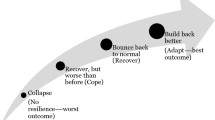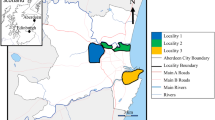Abstract
Sustainability is a laudable goal, but difficult to define and to implement because of the complexity of interlinked human and natural systems, and the uncertainty inherent in such complex systems. Resilience shows promise as a relevant and measurable attribute of sustainability, which itself defies measurement. Identification and assessment of conditions that are desirable, as well as those that are undesirable, are necessary in order to determine both the degree of progress toward sustainability and the removal of impediments to such progress. Communications incident to the identification and selection of indicators of resilience and sustainability are of potentially greater value than the indicators themselves and so should be given explicit consideration in the design of the indicators development process. Moving towards sustainability requires an iterative, continuing (open-ended), collaborative process. Academic institutions can assist in this process through activities that connect across political, social and discipline boundaries. Boundary organizations are those that have achieved a level of trust among the relevant constituents to management of sustainability and can help convert academic findings that are objectively neutral into options and alternatives that may be politically and economically feasible. The Sustainable Pennsylvania Program is developing demonstration projects with both state and local governmental agencies with the objective of building both capacity and will for moving towards sustainability.
Similar content being viewed by others
References
rangelands/pubs/milestones/MSFinal_AppA.pdf.>
Andrews, C.J.: 2002, Humble Analysis: The Practice of Joint Fact-Finding, Praeger Publishers, Westport, CT, USA.
Bell, S., and Morse, S.: 2000, Sustainability Indicators: Measuring the Immeasurable, Earthscan Publications Ltd., London, UK.
Beratan, K.K. and Karl, H.A.: (in review), 'Managing the science-policy interface in a complex and contentious world', in K. V. Thai, A. Sapat and J. Vos (eds.), Handbook of Globalization and the Environment, Marcel Dekker, New York, NY, USA.
Berkes, R., Colding, J. and Folke, C. (eds.): 2003, Navigating Social-Ecological Systems: Building Resilience for Complexity and Change, Cambridge University Press, Cambridge, UK.
Boothroyd, P.: 2000, 'Integrating economy, society, and environment through policy assessment', in R. F. Woollard, and A. S. Ostry (eds.), Fatal Consumption: Rethinking Sustainable Development, UCB Press, Vancouver, Canada, pp. 130-165.
Cash, D.W.: 2000, 'In order to aid in diffusing useful and practical information...: Cross-scale boundary organizations and agricultural extension', Discussion Paper 2000-10, Belfer Center for Science and International Affairs, Kennedy School of Government, Harvard University, Cambridge, MA, USA.
Clark, W.C.: 1999, 'Designing Effective Assessments of Global Environmental Issues: Towards a conceptual framework for learning from experience', GEA Project: 18, Harvard University, Cambridge, MA, USA.
Failing, L. and Gregory, R.: 2003, 'Ten common mistakes in designing biodiversity indicators for forest policy', J. Environ. Manage. 68, 121-132.
Folke, C., Pritchard, L., Jr., Berkes, F., Colding, J. and Svedin, U.: “The problem of fit between ecosystems and institutions.” International Human Dimensions Programme on Global Environmental Change, Working Paper No. 2. (1998). 26 January 2003. <http:// www.ihdp.uni-bonn.de/html/publications/workingpaper/workpaper01.html>
Gallopin, C.G.: 1997, 'Indicators and Their Use: Information for Decision Making', in B. Moldan, S. Billharz, R. Matravers (eds.), Sustainability Indicators, John Wiley & Sons, New York, NY, USA, pp. 13-17.
Gunderson, L.H. and Holling, C.S.: 2002, Panarchy: Understanding Transformations in Human and Natural Systems, Island Press, Washington, DC, USA.
Guston, D.H.: 1999, 'Stabilizing the boundary between U.S. politics and science: The role of the Office of Technology Transfer as a boundary organization', Social Studies of Science. 29, 87-111.
Moldan, B., Billharz, S. and Matravers, R. (eds.): 1997, Sustainability Indicators: Report of the Project on Indicators of Sustainable Development, John Wiley and Sons, New York, NY, USA.
Paehlke, R.: 2003, 'Environmental stability and urban life in America, Chapter 3', in N. J. Vig and M. E. Kraft (eds.), Environmental Policy: New Directions for the Twenty-first Century (5th Edition), CQ Press, Washington DC, USA, pp. 57-77.
Selman, P.: 1996, Local Sustainability: Managing and Planning Ecologically Sound Places, St. Martinís Press, New York, NY, USA.
Walker, B., Carpenter, S. Anderies, J., Abel, N., Cumming, G., Janssen, M, Lebel, L., Norberg, J., Peterson, G.D. and Pritchard, R.: 'Resilience management in social-ecological systems: a working hypothesis for a participatory approach', Conserv. Ecol. 6 (1), [online] URL: http://www.consecol.org/vol6/iss1/art14.
Rights and permissions
About this article
Cite this article
Beratan, K.K., Kabala, S.J., Loveless, S.M. et al. Sustainability Indicators as a Communicative Tool: Building Bridges in Pennsylvania. Environ Monit Assess 94, 179–191 (2004). https://doi.org/10.1023/B:EMAS.0000016887.95411.77
Issue Date:
DOI: https://doi.org/10.1023/B:EMAS.0000016887.95411.77




